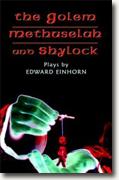The Golem, Methuselah, and Shylock
Edward Einhorn
book reviews:
· general fiction
· chick lit/romance
· sci-fi/fantasy
· graphic novels
· nonfiction
· audio books
· author interviews
· children's books @
curledupkids.com
· DVD reviews @
curledupdvd.com
newsletter
win books
buy online
links
home
for authors
& publishers
for reviewers

 |
The Golem, Methuselah, and Shylock: Three Plays Edward Einhorn Theater 61 Paperback 200 pages September 2005 |
|
This collection of three full-length and one single-act plays are a curious union of Jewish themes with expressionist and absurdist theatre. They use ample amounts of non-traditional techniques and provide an interesting sample of offbeat, off-Broadway work for those interested in modern theatre.
A figure of perfect innocence, it repeatedly questions the family, including the rabbi’s daughter, who is overwhelmed with grief and confusion. It claims that it is not the juggernaut they think it is, but this is brushed off. The tragedy of the play comes from the emotional shunning it receives, even from themselves-shunned Jews, which ends in a disturbing scene that heightens the golem’s innocence. Unfortunately, the play is weakened by flat characterization and poor dialogue. None of the characters seem too excited to be in the play; they remain poorly fleshed out, and their lines are flat. The play as a whole lacks tension, and while it is expected that the golem’s innocence is to meet with tragedy, it elicits little true compassion from an uncaring audience. As such, the tragic ending fails to hit home. The Living Methuselah is considerably more experimental and is much better for it. Methuselah, the oldest living man, is lying on a hospital bed with his similarly aged wife, Serach. A doctor tells him he will die in 24 hours, and Methuselah starts to see his life flash before his eyes. But as the doctor notes, in a life so long, the “flash” takes a while. Serach and the doctor act out roles as he goes through his life, focusing on the grand disasters he has escaped. The somewhat confusing structure of the piece works excellently: part flashback, part confession, the journey is a thorough insight into the lead’s mind, most notably his guilt at what it took to live so long. The doctor character is amazingly versatile, picking up and dropping roles as needed. What would be a confusing mess in lesser hands, Einhorn makes work, although there is some residual choppiness. A Shylock is about a man hearing that The Merchant of Venice’s Shylock is dying, which leaves him a large inheritance. He is led around by Hamlet (this time a woman—she explains that the newest reconception of her is as a female) to all the characters in Shakespeare’s play, until the protagonist finally confronts Shylock in the closing scene. Here again there is a non-traditional structure: the plot is not so much continuous action but a series of entrances and exits as the protagonist wanders through questioning as well as his own notions of Jewishness. His quest to find out whether Shylock, the traditional Jewish stereotype, forces him to consider the issues of pigeonholing faith. Einhorn is less capable of managing this structure than previously, as it is considerably more complex. But more disappointingly, he reverts to an all-too-clichéd ending of a final speech wherein the protagonist experiences revelation while “talking” with Shylock. The “discussion” is just a transparent mechanism for the final speech, and Shylock’s presence hardly feels necessary. To fall back on such a device feels like a copout; what is true for fiction is truer for drama—never let characters just announce their mental states. Although the play as a whole is innovative and a clever effort, the ending does drag it down considerably. The greatest difficulty with these plays is that they don’t read well. These unusual dramas seek to form impressions, appealing to intellect through visual and emotional influence. As the stage directions leave much open to interpretation, it can be rather difficult for the reader to grasp the full intentions of the piece. This is no fault of Einhorn’s: it is a problem for all absurdist theatre. More straightforward plays are easier to follow on paper, but these works demand more attention and visualization to achieve full effect. And while some of his absurdism gets away from him, Einhorn’s work certainly demands attention, even if it feels targeted toward a limited crowd. Originally published on Curled Up With A Good Book at www.curledup.com. © Max Falkowitz, 2007 |
| Also by Edward Einhorn: |
|
|
|
 Click here to learn more about this month's sponsor! |
|
| fiction · sf/f · comic books · nonfiction · audio newsletter · free book contest · buy books online review index · links · · authors & publishers reviewers |
|
| site by ELBO Computing Resources, Inc. | |
 Golem Stories is more traditional: in 1590’s Prague, Jews are persecuted and need a protector from an anti-Semitic priest. The rabbi’s daughter’s boyfriend has been killed by a mob, and the rabbi decides the violence has to stop. He makes a golem, a man made of clay who is part demon, which robotically does as it is told. But this monolithic figure begins to disturb the family when it takes on the likeness of the boyfriend who died and insists that it has his soul.
Golem Stories is more traditional: in 1590’s Prague, Jews are persecuted and need a protector from an anti-Semitic priest. The rabbi’s daughter’s boyfriend has been killed by a mob, and the rabbi decides the violence has to stop. He makes a golem, a man made of clay who is part demon, which robotically does as it is told. But this monolithic figure begins to disturb the family when it takes on the likeness of the boyfriend who died and insists that it has his soul.